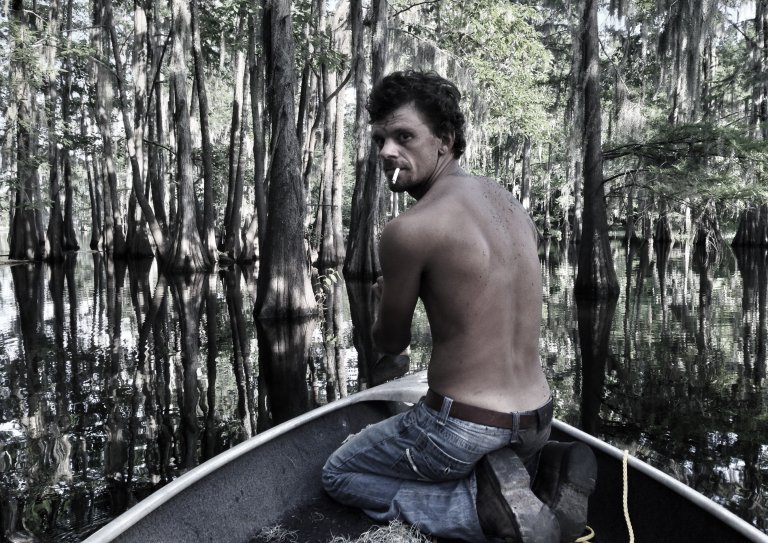A free state
Roberto Minervini’s Stop the Pounding Heart introduces us to a large Christian farming family, and a young rodeo aspirant and his circle. In the first 30 minutes, we see women working at chores such as milking goats and selling dairy goods at the market, and for the men, practice riding a dummy bronco and shooting guns. When Minervini brings together these two micro-communities through a “meet-cute” over a fence, he is completing a certain portrait of America—devout, fiercely driven by principles of freedom, skirting the economic margins yet epitomizing the mainstream, the all-American.
This dialectic of encounters and contrasts recurs throughout the Italian-born filmmaker’s oeuvre, which, with increasing directness, takes the double-edged ideal of freedom as its theme. The Carlson family in Stop the Pounding Heart radiates a daunting spiritual clarity—daughter Sarah, the story’s lead, at one point carries a lamb round her shoulders like a devotional painting of Jesus—but their patriarchal structure its own kind of social control. Minervini’s next film, The Other Side, elaborates upon the target practice of Stop the Pounding Heart with a grandiose vision of rebellion, as young men fire away with powerful weapons in desolate fields, but it’s an open question how their righteous fear and hatred of the federal government will improve their material circumstances.
Minervini does not claim to resolve these kinds of tensions and instead recognizes them as crucial and identifying facts of American identity. Part of his origin story as a filmmaker involves working in New York City at the turn of the millennium as an IT consultant, only to experience the contested, irregular election of George W. Bush and the September 11th, 2001, terrorist attacks in bewildering succession. Studying at the New School, he directed several shorts and then a trio of increasingly polished features rooted in Texas: The Passage, Low Tide, and Stop the Pounding Heart. He has had prestigious premieres in Cannes, Venice (most recently, What You Gonna Do When the World’s on Fire?), and the New York Film Festival.
Minervini’s Texas connection is a personal one: he had moved to Houston when his mother-in-law was terminally ill, a life experience that in turn inspired The Passage, a story about a middle-aged woman who has weeks to live. His casting of nonprofessionals requires him to developing a trusting, deeply personal rapport with the men and women who play their own vulnerable, unvarnished selves in front of his camera, overseen by his cinematographer collaborator Diego Romeo Suarez-Llanos, a highly mobile and sensitive chronicler. He works closely too with co-writer Denise Ping Lee, his partner; each movie seems to grow out of a relationship formed with someone from a previous production.
While Minervini’s method tends toward the organic—the result of long takes and an openness to emotional intensity whatever the constitutional toll—he is also evidently steeped in the multiple strands of concerted realism running throughout film history. He has referenced Cesare Zavattini, the Neorealist theorist, and there’s an echo with those earliest Italian portraits of the dispossessed in the boy left to his own devices in Low Tide, himself part of another Minervini double portrait with his addicted mother. But in addition to Italian masters such as Pasolini and Rossellini, he also cites the American Allan King and Brazil’s Osualdo Candeias as inspirations.
Invoking these legends of the medium might make Minervini sound more pretentious or precious than his films indicate. In fact, probably his most complex and troubling feature so far, The Other Side (sometimes titled simply Louisiana, after its setting), succeeds through its embrace of utterly human chaos—both within the heart and across society generally. Its first half trails, with intimacy and rawness, a drug-addicted man, Mark, and his partner, Lisa, showing the particular attention to skin texture and tone and lighting conditions that Minervini and Romero have honed as another mode of attunement to the rigors of being and experience. (Witness simply the puffily beleaguered face of the boy in Low Tide, already looking like a boxer in the ring of life.) Mark and Lisa’s love is messy and real, and before we might wonder where the filmmakers will go with their stories, The Other Side becomes reborn as an embedded look of right-wing militia communities.
This moment of rupture and change stands out in recent cinema (a nonfiction analogue, perhaps, to the narrative break portrayed in Mulholland Drive before 9/11), and with the election of Donald Trump, it has helped endow The Other Side with the quality of an unheeded prophecy. But if Minervini was a prophet, he was looking not into the future, but rather at the present that was in front of us if we cared to look. The freewheeling energy and passions on display in the film can be glorious and unnerving at the same time. “I wanted to be on the front line,” Minervini told me once in an interview. He has succeeded in placing us there with him, and it remains for us to open our eyes.
By Nicolas Rapold
Read more
View less


